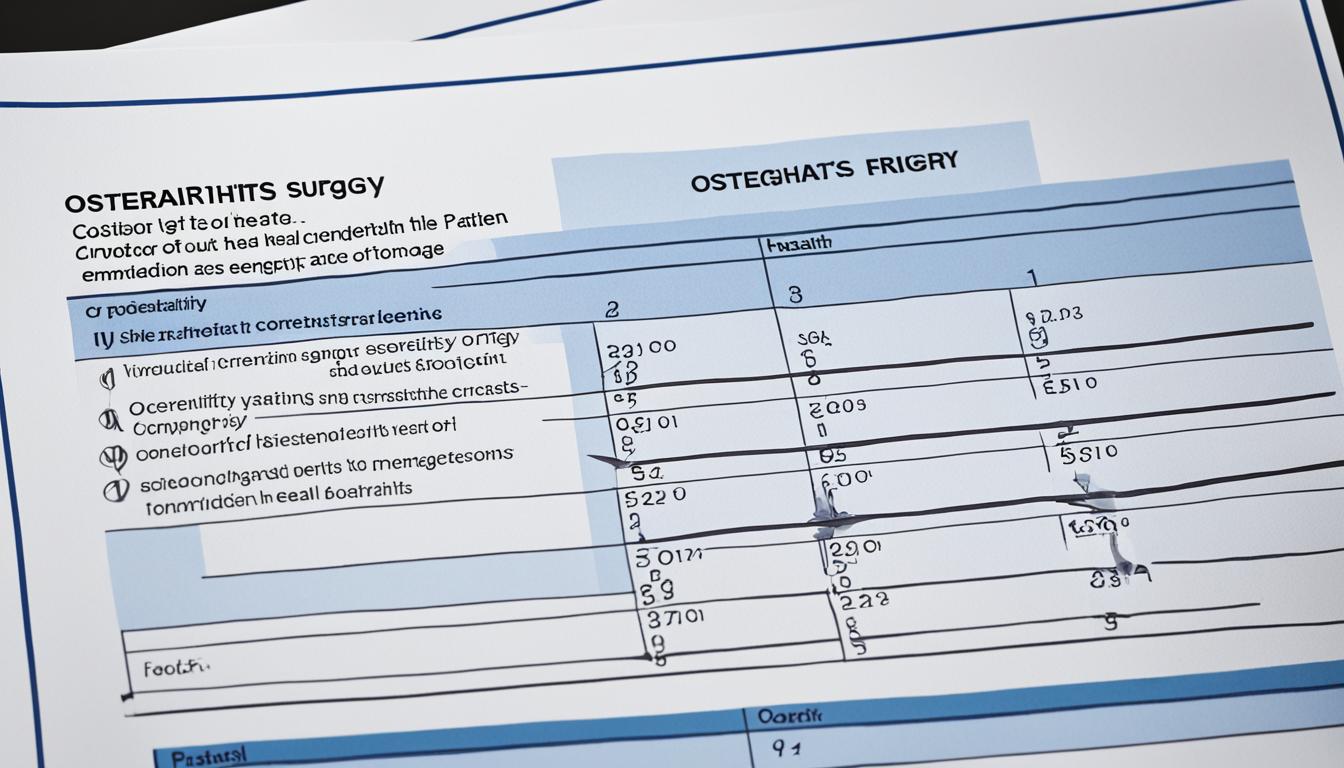Osteoarthritis Surgery Timing: Key Considerations
Welcome to our article on osteoarthritis surgery timing. If you or a loved one are suffering from osteoarthritis, you may be wondering when is the right time to consider surgery. In this article, we will discuss the important factors to consider when deciding on surgery for osteoarthritis and the recommended timing based on expert guidelines.
Osteoarthritis (OA) is a degenerative joint disease that can cause pain, stiffness, and reduced function in the affected joint. Nonoperative treatments such as physical therapy, weight reduction, and injections are often tried before considering surgery. However, when these treatments no longer provide sufficient relief, surgery may be a viable option to alleviate pain and improve joint function.
The American College of Rheumatology (ACR) and the American Association of Hip and Knee Surgeons (AAHKS) have issued guidelines on the timing of elective hip and knee arthroplasty for patients with symptomatic moderate to severe osteoarthritis or advanced osteonecrosis with secondary arthritis. These guidelines aim to improve patient outcomes by determining the optimal timing for surgical intervention.
While prompt surgery is generally recommended for individuals with moderate to severe osteoarthritis or advanced osteonecrosis, it’s important to note that the decision should be individualized. Factors such as the severity of the disease, the patient’s overall health, and their response to nonoperative treatments should be considered when determining the appropriate timing for surgery.
In the following sections, we will delve deeper into the factors that influence the timing of osteoarthritis surgery, the benefits and risks associated with the procedure, the success rate of surgery, the expected recovery time, and the considerations for delaying surgery. We hope that this article will provide you with valuable insights and help you make informed decisions regarding osteoarthritis surgery.
Factors Influencing Timing of Osteoarthritis Surgery
The decision to undergo osteoarthritis surgery is influenced by several key factors. These factors include the level of pain experienced by the patient, the extent of loss of joint function, and the response to nonoperative therapies. Nonoperative treatments such as physical therapy, braces, anti-inflammatory drugs, and injections are often prescribed as initial approaches to manage osteoarthritis. However, if these treatments fail to provide adequate relief and the pain and functional limitations persist, surgical intervention may be recommended.
When considering the timing of surgery, it is important to take into account the severity of the disease, the overall health of the patient, and their specific risk factors. Different surgical options for osteoarthritis may be available, such as joint replacement or arthroscopy, and the decision on which approach to take should be based on a comprehensive evaluation of the patient’s condition.
Open and informed discussions between the patient and healthcare provider are crucial in determining the most suitable timing for surgery. These discussions should thoroughly explore the potential benefits and risks of surgery, allowing for an individualized decision that takes into consideration the patient’s unique needs and circumstances.
Surgery can be a life-changing intervention for patients with osteoarthritis, providing relief from pain and restoring joint function. However, it is important to carefully weigh the potential benefits and risks before proceeding with any surgical option. By considering the factors that influence the timing of surgery and engaging in open communication with healthcare providers, patients can make informed decisions that maximize their chances of successful outcomes and improved quality of life.

Benefits of Osteoarthritis Surgery
Osteoarthritis surgery can provide several benefits for patients. It can alleviate pain, improve joint function and mobility, and enhance overall quality of life. Many patients experience a significant reduction in pain and improvement in joint function following surgery. Osteoarthritis surgery can also help prevent further joint damage and progression of the disease. It is important to note that the benefits of surgery may vary depending on individual factors such as the severity of the disease, the patient’s overall health, and their response to nonoperative treatments. Patients should discuss these potential benefits with their healthcare provider.

In addition to alleviating pain, osteoarthritis surgery offers improved joint function and mobility. This allows patients to regain the ability to perform daily activities, such as walking, climbing stairs, and participating in recreational activities.
Osteoarthritis surgery is also associated with enhanced overall quality of life. It can relieve the physical and emotional burden of chronic pain, improving mental well-being and allowing individuals to enjoy a more active and fulfilling lifestyle.
“Osteoarthritis surgery has been a life-changing experience for me. Before the surgery, I was constantly in pain and struggled to perform even simple tasks. Now, I can move without pain and enjoy activities that I once thought were impossible.”
Furthermore, osteoarthritis surgery helps prevent further joint damage and disease progression. By addressing the underlying cause of pain and dysfunction, surgery can halt the degenerative process and preserve joint integrity.
It is important to consider that the benefits of surgery may not be immediate and can vary from patient to patient. Some individuals may experience a rapid improvement, while others may require a longer recovery period. Nonetheless, with careful guidance from healthcare providers and adherence to post-operative instructions, patients can maximize the potential benefits of osteoarthritis surgery and regain a better quality of life.
Risks and Complications of Osteoarthritis Surgery
Like any surgical procedure, osteoarthritis surgery carries certain risks and potential complications. It is important for patients to be aware of these risks and discuss them with their healthcare provider before making a decision.
Infection: There is a small risk of infection following osteoarthritis surgery. Measures such as proper sterilization techniques and antibiotic prophylaxis are taken to minimize this risk.
Blood Clots: Deep vein thrombosis (DVT) and pulmonary embolism (PE) are potential complications after surgery. Precautions, such as early mobilization, compression stockings, and anticoagulant medications, are employed to reduce the risk of blood clots.
Nerve or Blood Vessel Damage: During surgery, there is a possibility of unintentional damage to nerves or blood vessels near the surgical site. Surgeons take precautions and use careful techniques to minimize this risk.
Allergic Reactions to Anesthesia: Some individuals may experience allergic reactions to anesthesia medications. Anesthesia providers carefully evaluate a patient’s medical history and take appropriate steps to manage this risk.
Prior to surgery, healthcare providers thoroughly assess a patient’s medical history and conduct pre-operative evaluations to identify and address any specific risks or concerns. Additionally, patients are given detailed instructions on pre- and post-operative care to minimize the likelihood of complications.
Common Risks of Osteoarthritis Surgery:
| Risk | Description |
|---|---|
| Infection | Possibility of infection at the surgical site |
| Blood Clots | Potential for deep vein thrombosis (DVT) or pulmonary embolism (PE) |
| Nerve or Blood Vessel Damage | Possibility of unintentional damage to nearby nerves or blood vessels |
| Allergic Reactions to Anesthesia | Potential for allergic reactions to anesthesia medications |
It is crucial for patients to have open and transparent discussions with their healthcare providers to fully understand the potential risks and benefits of osteoarthritis surgery. By being informed and actively involved in the decision-making process, patients can make confident choices about their treatment options.
Success Rate of Osteoarthritis Surgery
The success rate of osteoarthritis surgery is a crucial factor to consider when deciding on surgical intervention. It provides valuable insights into the effectiveness of the procedure and the expected outcomes for patients. Overall, the success rate of osteoarthritis surgery is generally high, with the majority of patients experiencing significant improvement in pain and function.
According to studies, the success rate for total joint arthroplasty, which is the most common surgical approach for osteoarthritis, is approximately 85-90%. This means that the majority of patients who undergo this procedure can expect a substantial reduction in pain and a significant improvement in joint function and mobility.
However, it is important to note that individual results may vary. The success rate can be influenced by various factors such as the severity of the disease, the patient’s overall health, and their response to nonoperative treatments. Patients should have realistic expectations and discuss the expected outcomes with their healthcare provider to ensure a comprehensive understanding of the potential benefits.
To provide further insights into the success rate of osteoarthritis surgery, below is a table summarizing the outcomes of total joint arthroplasty based on different factors:
| Factors | Success Rate |
|---|---|
| Severity of the disease | 85-90% |
| Patient’s overall health | 85-90% |
| Response to nonoperative treatments | 85-90% |
It is essential to consider these factors when discussing the potential outcomes of osteoarthritis surgery with patients. Clear communication and shared decision-making between healthcare providers and patients will lead to well-informed choices and realistic expectations.
Overall, the success rate of osteoarthritis surgery is encouraging, with significant improvements in pain and function for the majority of patients. However, individual factors can influence the outcome, highlighting the importance of personalized care and open discussions between patients and healthcare providers. By understanding the success rate and considering various factors, patients can make informed decisions about their osteoarthritis surgery and have realistic expectations for their recovery and long-term outcomes.
Recovery Time after Osteoarthritis Surgery
The recovery time following osteoarthritis surgery can vary depending on the specific procedure performed and individual factors. While each patient’s experience may differ, it is important to have a general understanding of the expected recovery timeline.
On average, patients can anticipate a few weeks of recovery time before they can resume their regular activities. During this initial phase, it is common to experience some discomfort and limited mobility as the body begins to heal. Rest and gentle movement are usually recommended during this period, allowing the surgical site to properly heal without undue stress.
However, it is crucial to understand that complete healing and full restoration of joint function may take several months. The body needs time to adapt to the changes made during surgery and to undergo the natural healing process. It is important to be patient and follow the post-operative instructions provided by your healthcare provider.
Healthcare providers typically create individualized rehabilitation plans to aid in the recovery process. These plans often entail physical therapy sessions, exercises, and at-home care instructions to promote strength, flexibility, and mobility. Engaging in these activities under the guidance of your healthcare provider can help facilitate a smoother and more efficient recovery.
Key Factors That Influence Recovery Time
Several factors can influence the recovery time after osteoarthritis surgery. These include:
- The type of surgery performed: Different procedures may have varying levels of invasiveness and recovery times. For example, minimally invasive arthroscopy may have a shorter recovery period compared to joint replacement surgery.
- The extent of joint damage: Severe osteoarthritis may require more extensive surgical intervention, which can impact the recovery time. The more extensive the surgery, the longer the healing process.
- Overall health and fitness: Factors such as overall physical health, age, and pre-existing medical conditions can influence the body’s ability to heal. Maintaining a healthy lifestyle and following any recommendations provided by your healthcare provider can support a more efficient recovery.
It is essential to maintain open communication with your healthcare provider throughout the recovery period. They can offer guidance, answer any questions or concerns, and monitor your progress to ensure a successful recovery.
| Expected Recovery Timeline | Description |
|---|---|
| First few weeks | Focus on rest, pain management, and gentle movement as the body begins to heal. |
| First month | Gradually increase mobility and engage in physical therapy exercises to regain strength and flexibility. |
| Up to three months | Continue with physical therapy exercises and gradually increase activity levels. Joint function and mobility should noticeably improve. |
| Up to six months | The joint should continue to heal, and patients can expect further improvement in pain relief and overall function. |
Considerations for Delaying Osteoarthritis Surgery
While the guidelines recommend prompt surgery for most patients with moderate to severe osteoarthritis, there may be situations where delaying surgery is appropriate. Factors that may warrant delaying surgery include patients with certain risk factors such as obesity or poorly controlled diabetes, as well as patients who may benefit from nonoperative treatments to optimize their condition before surgery.
The decision to delay surgery should be made on an individual basis, taking into account the patient’s overall health, preferences, and specific circumstances. By considering these factors, healthcare providers can help guide patients in making an informed decision about the timing of their osteoarthritis surgery.
Factors to Consider for Delaying Surgery
- Patient Risk Factors: Patients with comorbidities such as obesity or poorly controlled diabetes may need additional time to optimize their health before undergoing surgery. Addressing these risk factors can help reduce the likelihood of complications and improve surgical outcomes.
- Maximizing Nonoperative Treatments: Some patients may benefit from trying additional nonoperative treatments to manage their osteoarthritis symptoms. These treatments may include physical therapy, weight reduction, and medication. Delaying surgery allows patients to exhaust all nonoperative options and determine if they are effective in alleviating their symptoms.
- Complex Cases: In certain cases, the severity or complexity of the osteoarthritis may necessitate additional time to plan and prepare for surgery. This can involve consultations with multiple specialists, additional imaging or diagnostic tests, or the need for a more specialized surgical approach.
“Determining the optimal timing for osteoarthritis surgery requires careful consideration of each patient’s unique circumstances. It’s important for us to take into account their overall health, preferences, and potential risk factors before proceeding with surgery.”
By evaluating these factors and engaging in open discussions with patients, healthcare providers can ensure that the decision to delay osteoarthritis surgery is well-informed and aligned with the individual’s best interests. Ultimately, the goal is to optimize patient outcomes and improve their quality of life.
Conclusion
The decision of when to have surgery for osteoarthritis is a crucial one, and it should take into account various individual factors, including the severity of the disease, the patient’s overall health, and their response to nonoperative treatments. Generally, it is recommended to opt for prompt surgery for most patients with moderate to severe osteoarthritis to prevent worsening of pain and functional limitations. However, there are cases where delaying surgery may be appropriate, such as when patients have certain risk factors or can benefit from nonoperative treatments before surgery.
Collaborative decision-making between patients and healthcare providers is essential in determining the optimal timing for osteoarthritis surgery. This process involves considering the potential benefits and risks of surgery and tailoring the decision to address the specific needs and circumstances of each patient. The primary objective is to optimize patient outcomes and enhance their overall quality of life.
In summary, when to have surgery for osteoarthritis is not a one-size-fits-all answer. It requires careful evaluation and assessment of individual factors. By following evidence-based guidelines and engaging in informed discussions with healthcare providers, patients can make well-informed decisions about the timing of their osteoarthritis surgery, ultimately aiming for the best possible outcome.
FAQ
When should I consider surgery for osteoarthritis?
Surgery for osteoarthritis is typically considered when nonoperative treatments such as physical therapy and medications are no longer providing adequate relief and the pain and loss of function are significantly impacting daily life.
What factors influence the timing of osteoarthritis surgery?
The timing of osteoarthritis surgery is influenced by factors such as the severity of the disease, the patient’s level of pain and loss of function, and their response to nonoperative therapies. Other considerations include the patient’s overall health and specific risk factors.
What are the benefits of osteoarthritis surgery?
Osteoarthritis surgery can alleviate pain, improve joint function and mobility, and enhance overall quality of life. Many patients experience a significant reduction in pain and improvement in joint function following surgery. It can also help prevent further joint damage and disease progression.
What are the risks and complications of osteoarthritis surgery?
Like any surgical procedure, osteoarthritis surgery carries certain risks and potential complications, including infection, blood clots, nerve or blood vessel damage, and allergic reactions to anesthesia. However, the overall risks of complications are generally low, and healthcare providers take measures to minimize these risks.
What is the success rate of osteoarthritis surgery?
The success rate of osteoarthritis surgery is generally high, with approximately 85-90% of patients experiencing significant improvement in pain and function. However, individual results may vary depending on factors such as the severity of the disease and the patient’s overall health.
What is the recovery time after osteoarthritis surgery?
The recovery time after osteoarthritis surgery can vary depending on the type of procedure and individual factors. In general, patients can expect a few weeks of recovery before they can resume regular activities. However, it may take several months for the joint to fully heal and for the patient to regain full function.
Are there situations where delaying osteoarthritis surgery is appropriate?
Yes, there may be situations where delaying surgery is appropriate, such as for patients with certain risk factors or those who may benefit from nonoperative treatments to optimize their condition before surgery. The decision to delay surgery should be made on an individual basis, considering the patient’s overall health, preferences, and specific circumstances.
How do I decide when to have surgery for osteoarthritis?
The decision to have surgery for osteoarthritis should be made through shared decision-making between the patient and their healthcare provider. It is important to have open and informed discussions about the potential benefits, risks, and timing of surgery, taking into account individual factors and preferences.
Source Links
- https://rheumatology.org/press-releases/new-guideline-introduces-recommendations-for-optimal-timing-of-elective-hip-or-knee-arthroplasty-
- https://pubmed.ncbi.nlm.nih.gov/38015121/
- https://www.rheumatologyadvisor.com/home/topics/osteoarthritis/guidelines-for-timing-of-tja-patients-with-symptomatic-oa-or-on/







